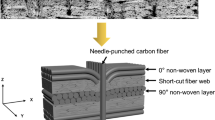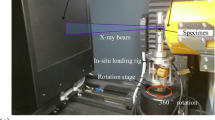Abstract
In this study, we investigate the feasibility of in-situ crack propagation by using a double cleavage drilled compression (DCDC) specimen showing a slow crack velocity down to 0.03 mm/s under 0.01 mm/s of displacement control. Finite element analysis predicted that the DCDC specimens would show at least 4.3 fold delayed crack initiation time than conventional tensile fracture specimens under a constant loading speed. Using DCDC specimens, we were able to observe the in-situ crack propagation process in a particle reinforced transparent polymer composite. Our results confirmed that the DCDC specimen would be a good candidate for the in-situ observation of the behavior of particle reinforced composites with slow crack velocity, such as the self-healing process of micro-particle reinforced composites.
Similar content being viewed by others
References
Brown, E. N., Sottos, N. R. and White, S. R., 2002, “Fracture Testing of a Self-healing Polymer Composite,”Experimental Mechanics, Vol. 42, No. 4, pp. 372–379.
Brown, E. N., Kessler, M. R., Sottos, N. R. and White, S. R., 2003, “In Situ Poly (Urea-formaldehyde) Microcapsulation of Dicyclopentadiene,”Journal of Microcapsulation, Vol. 20, No. 6, pp. 719~730.
Brown, E. N., White, S. R. and Sottos, N. R., 2004, “Mircocapsule Induced Toughening in a Self-healing Polymer Composite,”Journal of Materilals Science, Vol. 39, pp. 1703–1710.
Crichton Stephen N. and Tomozawa Minoru, 1999, “Subcriticai Crack Growth in a Phosphate Laser Glass,”Journal of the American Ceramic Society, Vol. 82, No. 11, pp. 3097–3104.
He, H. Y., Turner, M. R. and Evans, A. G., 1995, “Analysis of the Double Cleavage Drilled Compression Specimen for Interface Frafcture Energy Masurements Over a Range of Mode Mixties,”Acta Metall. Mater, Vol. 43, No. 9, pp. 3453–3458.
Janssen, C, 1974, “Specimen for Fracture Mechanics Studies on Glass,”Proceedings of the 10th International Conference on Glass, Kyoto, Japan, Julu 8–13, pp. 10.23–10.30.
Janssen, C., 1980, “Fracture Characteristics of the DCDC Specimen, Report No. R-8074,”Corning Glass Works, Corning, NY.
Jenne Thomas A., Keat William D. and Larson Michael C., 2003, “Limits of Crack Stability in the Double Cleavage Drilled Compression Specimen,”Engineering Fracture Mechanics, Vol. 70, pp. 1697–1719.
Kagawa Yutaka and Goto Ken, 1998, “Direct Observation and Modeling of the Crack-fibre Interaction Process in Continuous Fibre-reinforced Ceramics: Model Experiments,” Materials Science and Engineering, A250, pp. 285–290.
Kessler, M. R. and White, S. R., 2001, “Self-activated Healing of Delamination Damage in Woven Composites,”Composites: Part A, Vol. 32, pp. 683–699.
Kessler, M. R., Sottos N. R. and White S. R., 2003, “Self-healing Structural Composite Materials,”Composites, Part A, Vol. 34, pp. 743–753.
Lee, Y. K. and Tomozawa, M., 1999, “Effects of Water Content in Phosphate Glasses on Slow Crack Growth Rate,” Non-crystalline Solids Vol. 248, pp. 203–210.
Michalske, T. A., Smith, W. L. and Chen, E. P., 1993, “Stress Intensity Calibration for the Double Cleavage Drilled Compression Specimen,”Engineering Fracture Mechanics, Vol. 45, No. 5, pp. 637–642.
Weiderhorn, S. M., 1967, “Influence of Water Vapor on Crack Propagation in Soda-lime Glass,”Journal of the American Ceramic Society, Vol. 50, No. 8, pp. 407–417.
White, S. R., Sottos, N. R., Geubelle, P. H., Moore, J. S., Kessler, M. R., Sriram, S. R., Brown, E. N. and Viswanathan, S., 2001, “Autonomic Healing of Polymer Composites,” Nature, Vol. 409, pp. 794–817.
Yoshida Satoshi, Jun Matsuoka and Naohiro Soga, 2001, “Crack Growth Behavior of Zinc Tellurite Glass With or Without Sodium Oxide,”Journal of Non-crystaline Solids, Vol.279, pp. 44–50.
Author information
Authors and Affiliations
Corresponding author
Rights and permissions
About this article
Cite this article
Lee, Y.S., Yoon, Y.K., Jeong, B.Y. et al. In-situ crack propagation observation of a particle reinforced polymer composite using the double cleavage drilled compression specimens. J Mech Sci Technol 20, 310–318 (2006). https://doi.org/10.1007/BF02917513
Received:
Revised:
Issue Date:
DOI: https://doi.org/10.1007/BF02917513




